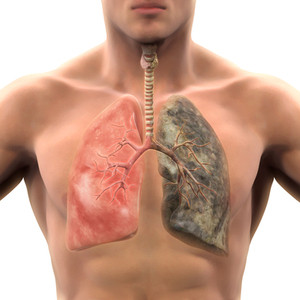
What is bronchial carcinoma?
Bronchial carcinoma is also colloquially known as lung cancer and is one of the most common cancers in Europe. Smokers in particular often develop bronchial carcinoma, which can be treated with chemotherapy or surgery, but is rarely completely cured.
What are the symptoms of bronchial carcinoma?
At the beginning of the disease, lung cancer often causes no or only unspecific symptoms. In addition to a general feeling of fatigue, the patient may also suffer from a cough or chest pain. However, these symptoms can have many different causes, such as bronchitis or a cold, which is why bronchial carcinoma is often not diagnosed at an early stage. As with other cancers, the earlier bronchial carcinoma is diagnosed and treatment is started, the better the chances of a cure.
A bronchial carcinoma that is already in an advanced stage brings with it pronounced symptoms of the disease. These include, for example, rapid weight loss, bloody sputum and/or shortness of breath. If the bronchial carcinoma has already formed metastases, further symptoms can occur, for example headaches, impaired vision and balance and/or headaches if there are already metastases in the brain.
What stages of cancer is bronchial carcinoma classified into?
Like other types of cancer, bronchial carcinoma is caused by degenerated cells. These degenerated cells multiply uncontrollably and push back healthy tissue in the local area. At a later stage, individual cancer cells can also spread throughout the body via the blood and lymph vessels and thus form metastases elsewhere. Based on this course of development, physicians divide bronchial carcinoma into TNM classifications, which are based on an international system to describe the spread of the tumour. "T" stands for tumour size, "N" for lymph node involvement (Nodi lymphatici) and "M" for the presence of metastases:
- Tis: Early cancer stage, i.e. the tumour is still localised
- T1: The tumour has reached a maximum diameter of 3 cm and is still limited to the lung tissue or the pleura.
- T2: The tumour has reached a diameter of more than 3 to a maximum of 5 cm and affects the main bronchus or or the pleura or part of the lung.
- T3: The tumour size is at least 5 cm and a maximum of 7 cm and affects the inner chest wall or has already developed an additional tumour nodule in the same lobe of the lung.
- T4: The tumour is larger than 7 cm and has already affected other organs or developed an additional tumour node in another lung lobe.
- N0: The lymph nodes are not affected.
- N1: Lymph nodes on the same side of the body as the tumour are already affected.
- N2: Lymph nodes have formed in the mediastinum and/or at the outlet of the two main bronchi on the same side as the tumour.
- N3: The lymph nodes in the mediastinum or at the outlet of the two main bronchi on the opposite side (contralateral) of the tumour as well as the lymph nodes on the neck and above the collarbone are affected.
- M0: There are no metastases present.
- M1: Metastases are present.
- Lung cancer stage 0: corresponds to the TNM classification Tis N0 M0. According to this, there is an early form of cancer which is still locally limited (carcinoma in situ), has not yet affected the lymph nodes and has not yet formed any distant metastases.
- Lung cancer stage I: is divided into A and B. Stage IA corresponds to a classification of T1 N0 M0: The malignant bronchial carcinoma has a maximum diameter of 3 cm, is surrounded by lung tissue or lung pleura and does not affect the main bronchus. There is also no lymph node involvement and no distant metastases. Stage IB corresponds to the classification of T2a N0 M0: The tumour is more than 3 to a maximum of 4 cm in diameter, does not affect the lymph nodes and has not metastasised to other organs or tissues. At this stage, lung cancer has the best prognosis and is often still curable.
- Stage II lung cancer: is divided into A and B. Stage IIA corresponds to the classification T2b N0 M0: The diameter of the tumour is more than 4 and maximum 5 cm, does not yet affect any lymph nodes and has not yet formed any distant metastases. Stage IIB corresponds to the classification T1 (a to c) with lymph node involvement of type N1, but there are no distant metastases (M0). In stage II, bronchial carcinoma can only be cured in some cases after very complex treatment. However, statistically, the patient's life expectancy already decreases significantly.
- Lung cancer stage III: As soon as the lymph nodes are affected, but there are no distant metastases yet, this includes tumours of any size. In this stage, the bronchial carcinoma is usually so far advanced that it can only be cured in rare cases.
How can lung cancer be treated?
The treatment of bronchial carcinoma always depends on the stage of the cancer, but also on the patient's general state of health. Doctors generally distinguish between curative and palliative therapy. While curative therapy aims to cure lung cancer, palliative therapy is used for those who can no longer be cured. Palliative therapy is thus intended to prolong the patient's life and alleviate his or her symptoms.
Generally, bronchial carcinoma can either be removed by surgery or the fast-growing cancer cells can be treated by chemotherapy or radiotherapy. Sometimes combinations of the respective treatment options are also used.
Two common viruses are associated with lung cancer:
- Papillomavirus / Human Papillomavirus (HPV)
- Rubeolae Virus
CAFL:
462, 776, 852, 1,582k, 2,104k, 2,144k, 2,184k
